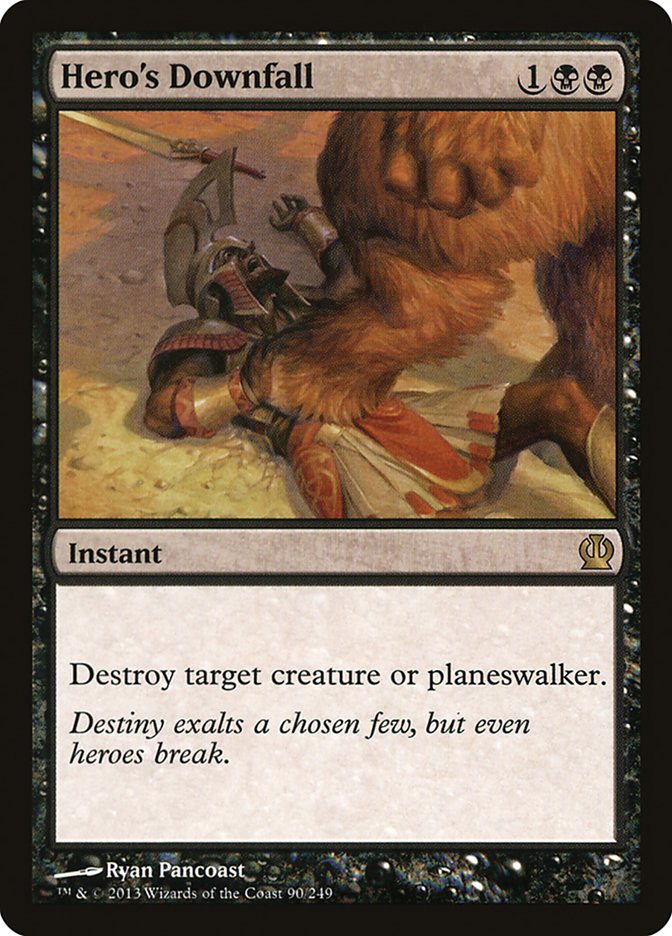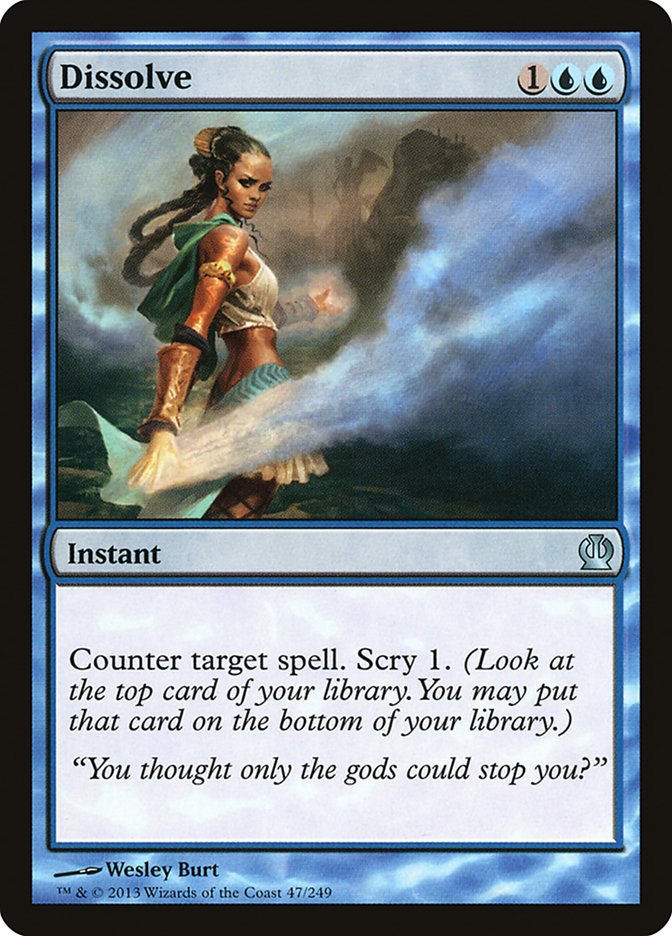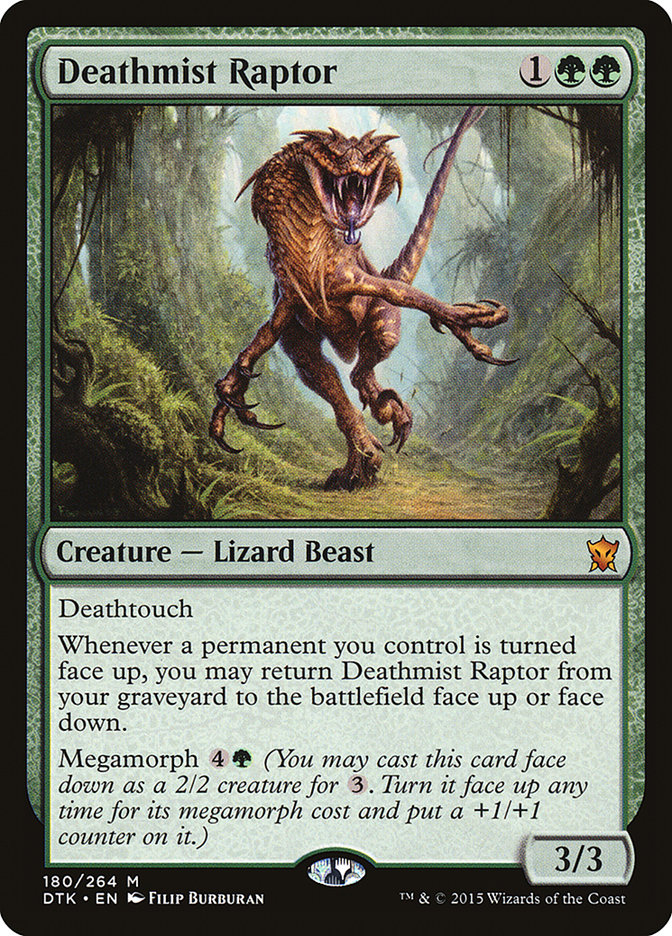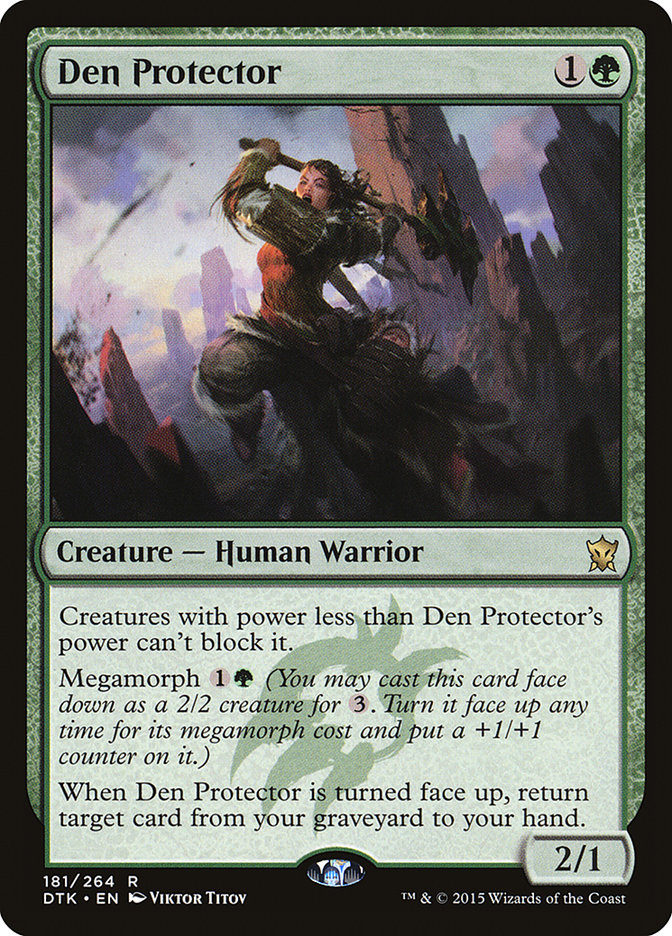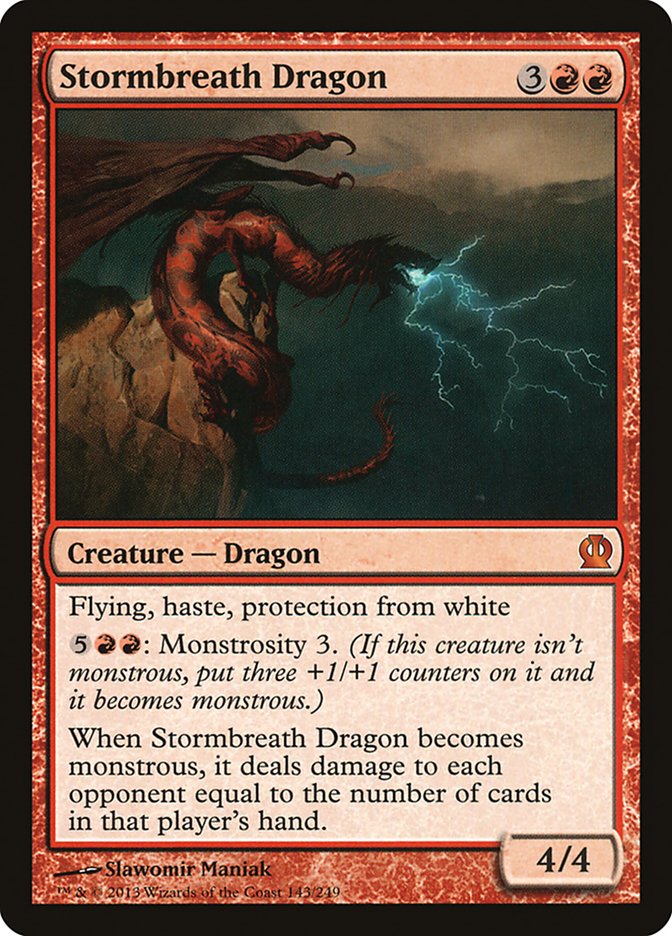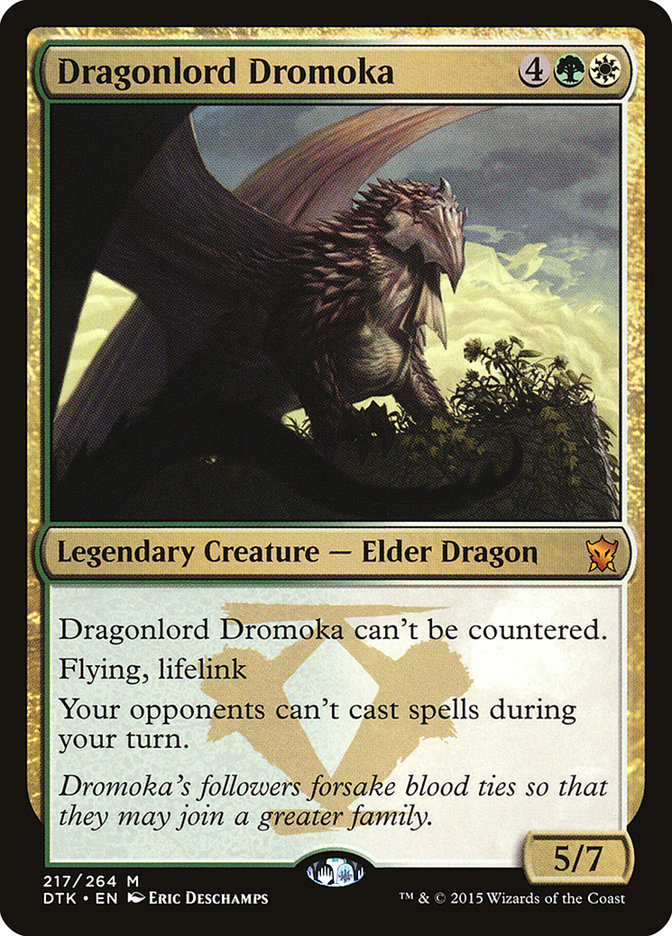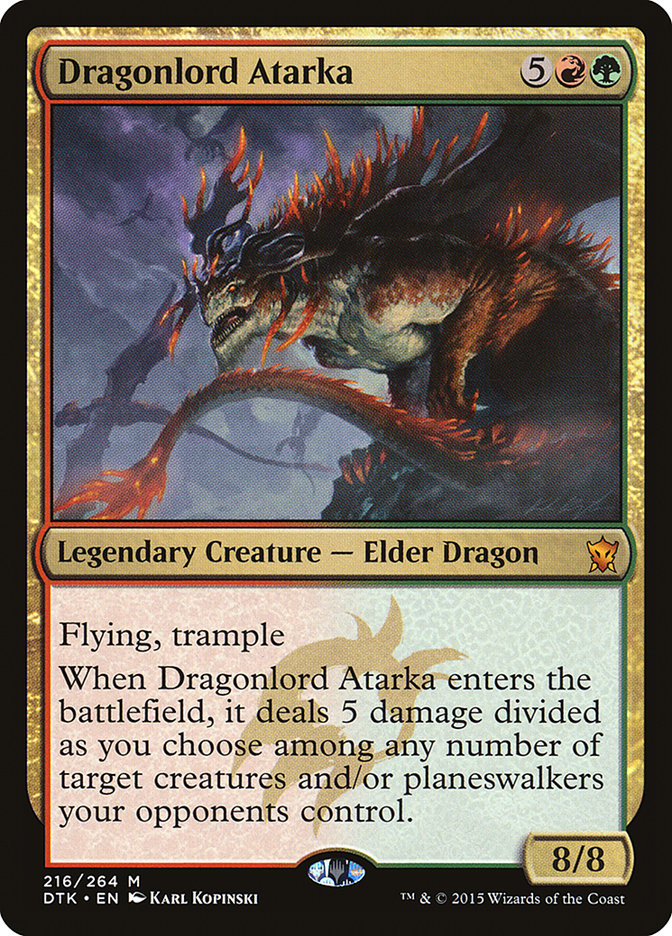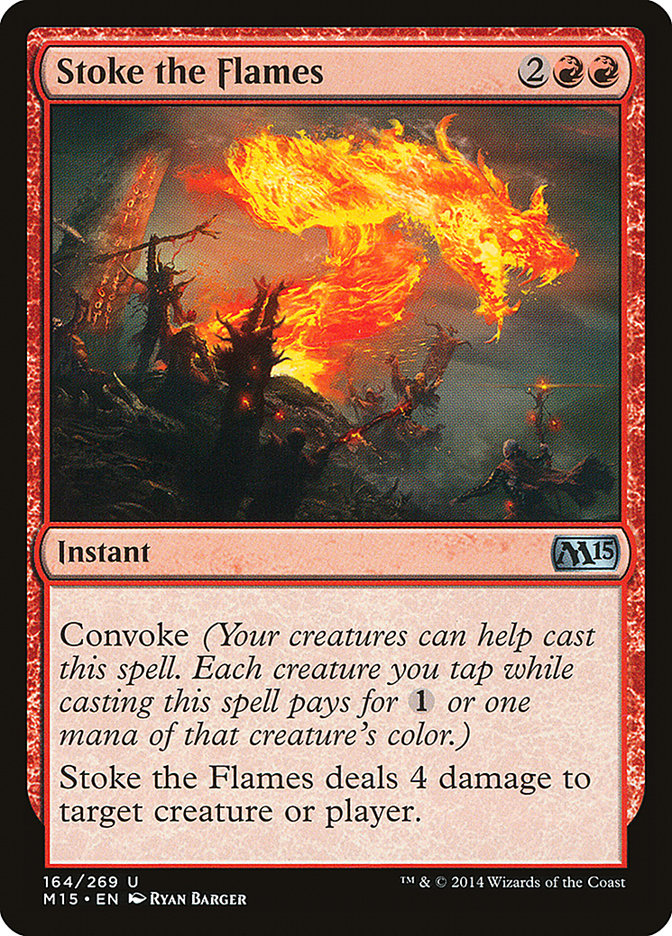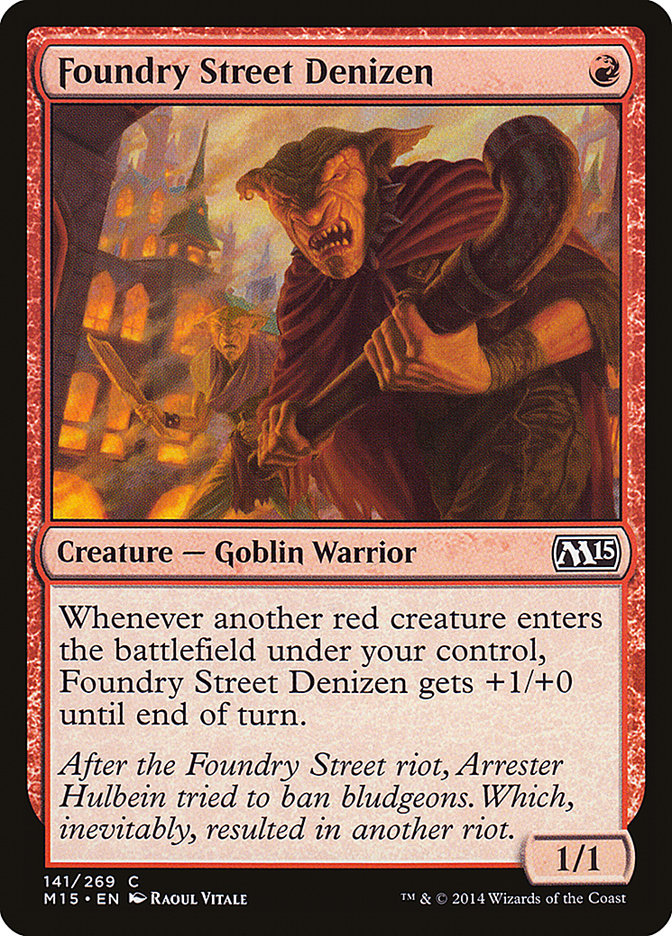With G/R Dragons winning the Open Series in Dallas two weekends ago and clearly being the best-positioned deck for that weekend, we’ve seen Standard come
full circle to Chris VanMeter’s Open Series win the weekend before Pro Tour Dragons of Tarkir in Syracuse. This cyclical pattern is something we’ve come to
expect from this Standard format and is a testament to its depth. Regardless of what deck pops up as the best one week, there are options that exist to
exploit it the following week.
The most obvious cycle in the format is a Rock-Paper-Scissors dynamic going on between Control, Deathmist Raptor, and Dragonlord Atarka.
Creatures (6)
Planeswalkers (1)
Lands (27)
Spells (26)

Of the metagame points, I feel like this has been the most explored. There was the two-week span after the Pro Tour where it seemed like Esper Dragons
might just break open the format and basically everyone
was talking about
how to play or beat it.
When It Wins:
Blue Control is the best-positioned deck when people are trying to go over the top with midrange decks. The cards in this deck are reminiscent of what
control looked like when I started really playing Standard, back when midrange was actually a joke deck. The most obvious points here are the return of
Counterspell in Silumgar’s Scorn and the return of Fact or Fiction-level card draw with Dig Through Time. Dragonlord Ojutai is a bit more expensive than
Psychatog, but it’s still pretty close to one shot lethal with the Anticipate trigger.
As a result, this deck is best at punishing the same decks that past iterations of Blue Control drove out of existence for years. If your opponents are
trying to tap out for Elspeth, Sun’s Champion or Dragonlord Atarka, they will not beat the ole Temple of Deceit + “Go” gameplan. If their deck has a bunch
of removal spells to handle opposing threats, you will bury them in virtual card advantage. If their threats exist but aren’t especially good at applying
pressure, they will never force you out of position and you will set up for a better lategame than they can present.
How to Exploit It:
Even if the blue cards have mostly returned to the power levels of fifteen years ago, that doesn’t mean their opposition has also reverted.
If U/B Control has historically beat up on creatures that don’t clock well, threat-light decks with virtual blanks, and clunky finishers, play the
opposite. The other important part is being able to put the U/B player out of position. Michael Majors wrote
an excellent article about the topic of being “in position” or “having the initiative” last week, so soak that all in if you want to beat U/B Control.
Within this specific Rock-Paper-Scissors, Thoughtseize and countermagic is how the out of position part is accomplished. Thoughtseize at the right time to
clear their best way to fight your gameplan, or apply pressure and counter their key turning point spell. The other way to force the U/B player out of
position is cheap threats backed by haste creatures or instant-speed options. The pairing here is important: You need to punish both the plan of staying
back and playing three mana answers by going under it with tokens or less expensive creatures, and punish the inevitable Crux of Fate that tries to stop
the swarm plan.
Similarly, the decks that are playing to beat control are very light on answers that control can blank by just not playing threats. That means the
aggressive decks have a lot more copies of Thoughtseize and Valorous Stance over maxing out on Dromoka’s Command or Hero’s Downfall. If your deck can hang
going late and likely wants access to Hero’s Downfall to pick off the eventual Ashiok, Nightmare Weaver, Ugin, the Spirit Dragon, or tapped Dragonlord
Ojutai, that still means keeping your Bile Blight count low.
The clunky threat part is the most negotiable. It’s not like a resolved Elspeth, Sun’s Champion isn’t going to be a fine way to win the game against
control, it’s just that it can’t be your Plan A. You need to get out on the board before trying to cast your six- or seven-drop for it to have any chance
of mattering. This is similar to the Valorous Stance situation mentioned above: You probably don’t want Valorous Stance against U/B or Esper and will
sideboard it out if you can, but if you draw the card, it has relevant text.
Creatures (29)
- 4 Elvish Mystic
- 4 Sylvan Caryatid
- 4 Fleecemane Lion
- 4 Courser of Kruphix
- 4 Whisperwood Elemental
- 2 Stratus Dancer
- 3 Den Protector
- 4 Deathmist Raptor
Planeswalkers (2)
Lands (33)
Spells (5)

Creatures (21)
- 4 Courser of Kruphix
- 4 Satyr Wayfinder
- 4 Siege Rhino
- 1 Tasigur, the Golden Fang
- 4 Den Protector
- 4 Deathmist Raptor
Planeswalkers (3)
Lands (24)
Spells (12)

Creatures (24)
- 4 Elvish Mystic
- 4 Fleecemane Lion
- 4 Courser of Kruphix
- 2 Warden of the First Tree
- 2 Hidden Dragonslayer
- 4 Den Protector
- 4 Deathmist Raptor
Lands (24)
Spells (12)

When It Wins:
The Deathmist Raptor + Den Protector duo is really just about grinding card advantage. The reason it is good is that it does so while keeping both your
board and hand well-stocked, while traditional card advantage usually does one or the other. You either get your Divination or your Wingmate Roc, not both
at once. In the end, this means that most decks that try to play the one-for-one game with some end method of recouping the advantage like Dig Through Time
are going to fail to keep up on one aspect. Either they burn all their cards and realize that they have nothing and you still have cards in hand, or they
try to keep card parity and end up taking too much damage from the board of three-power attackers that was providing the card advantage to begin with. The
engine is also brutal against any deck where a 3/3 deathtouch for three trades well, as the second time around is backbreaking.
The other thing this pairing does is recur spells. This is really just tutoring the subset of your deck that is “spells I’ve already cast this game.”
Snapcaster Mage really drove home how brutal this can be when sideboard cards get involved, or really just any other card that is situationally
backbreaking in a matchup. In Standard, the cases where this is really pronounced are Thoughtseize, Disdainful Stroke, and Dromoka’s Command. The first two
mean that any Den Protector deck is capable of bleeding control dry by repeatedly tearing apart their gameplan, and the latter really drives home the point
that Dromoka’s Command has removed Outpost Siege, Mastery of the Unseen, Jeskai Ascendancy, and similar cards with the enchantment type from the metagame.
How to Exploit It:
What if card advantage just didn’t matter?
Den Protector’s immediate predator is decks that play the Cruel Ultimatum gameplan. Who cares about the opponent getting back an Abzan Charm and drawing
two more cards when that still doesn’t stop my Elspeth, Sun’s Champion churning out tokens? Or how many Hero’s Downfalls can you actually produce in time
to beat Thunderbreak Regent, Stormbreath Dragon, and Haven of the Spirit Dragon bringing them back? This same effect can be accomplished via aggression.
Did you draw your Drown in Sorrow to handle my Hordeling Outburst? If no, you don’t get a fifth turn.
There are also points where the Den Protector decks can get inbred trying to outcard each other. The G/W Collected Company deck is an example of this, as
while it performs very well against the Den Protector mirror and control, it opens up a lot of holes other lists don’t have. Play Brimaz, King of Oreskos
and Courser of Kruphix and you can’t ever handle a Stormbreath Dragon, but playing Aspect of Hydra means you can’t beat Hordeling Outburst. At least the
Abzan lists can interact with Stormbreath Dragon (even if the matchup isn’t great) and have Drown in Sorrow to beat Red decks.
Creatures (25)
- 4 Elvish Mystic
- 4 Sylvan Caryatid
- 4 Stormbreath Dragon
- 4 Courser of Kruphix
- 2 Genesis Hydra
- 3 Dragonlord Atarka
- 4 Thunderbreak Regent
Planeswalkers (3)
Lands (24)
Spells (8)

Creatures (20)
- 4 Stormbreath Dragon
- 4 Goblin Rabblemaster
- 4 Seeker of the Way
- 2 Kolaghan, the Storm's Fury
- 2 Soulfire Grand Master
- 4 Thunderbreak Regent
Lands (25)
Spells (15)

Creatures (30)
- 3 Polukranos, World Eater
- 4 Sylvan Caryatid
- 2 Arbor Colossus
- 4 Courser of Kruphix
- 3 Genesis Hydra
- 4 Rattleclaw Mystic
- 4 Whisperwood Elemental
- 2 Dragonlord Atarka
- 2 Den Protector
- 2 Surrak, the Hunt Caller
Planeswalkers (3)
Lands (24)
Spells (3)
Sideboard

Creatures (27)
- 4 Sylvan Caryatid
- 3 Courser of Kruphix
- 4 Satyr Wayfinder
- 2 Dragonlord Silumgar
- 1 Dragonlord Atarka
- 2 Dragonlord Dromoka
- 4 Den Protector
- 3 Dragonlord Ojutai
- 4 Deathmist Raptor
Lands (25)
Spells (8)

When It Wins:
This deck plays Primeval Titan Magic. Slam a threat that wins games quickly and in a relatively non-interactive way. If that fails, repeat until opponent
is dead or you run out of threats. As a result of this, the formula for when Dragons is good is very simple. If your opponent can’t handle your Dragons
well enough, they probably will just die to them. Note that “handling” Dragonlord Atarka for the most part is not playing things that die to it or winning
the game before it hits the board. The rise of this deck in response to Den Protector nonsense mostly has to do with Stormbreath Dragon being quite
effective against Abzan and the Den Protector decks not playing a game that prevents you from casting Dragonlord Atarka to erase all of their card
advantage.
Dragons is also really good at playing the racing game. Another one of the reasons it excels when Abzan is at a high point is that the normal plan of
beating anything with Siege Rhino into Siege Rhino is actually not a lock against Dragons. Haste, Crater’s Claws, and random things like Draconic Roar add
up really fast, and the Dragons player is always the one choosing to block or not while the opponent has the options of attack and attack harder in the
face of fliers.
All of this comes together towards Dragons being a bit of a midrange trump, again much like Primeval Titan was. The matchup isn’t quite that lopsided, but
the same essence carries through.
How to Exploit It:
Dragons is relatively threat-light in all of its incarnations. While just having some removal isn’t usually enough, having a ton of answers often is. It
also doesn’t help that all of the Dragons cost way more than all of the corresponding answers. Even the least expensive one (Thunderbreak Regent) gets
tempo’ed out by the supposedly expensive but generic answers (Dissolve, Hero’s Downfall).
The cost point in trading for removal creates another issue. Thunderbreak Regent is a great card when you cast it at parity or ahead, but it is rather bad
on the defensive. Four toughness puts it into Stoke the Flames range, and unlike Siege Rhino, the “guaranteed damage” it provides doesn’t kick in if your
opponent decides to just race the card and doesn’t push you out of racing range. Stormbreath Dragon and Dragonlord Ojutai aren’t much better at stopping an
army, and hoping to get to Dragonlord Dromoka or Dragonlord Atarka is really a best case scenario even when your mana creatures aren’t being removed. Just
attacking early and hard is often good enough to beat Dragons, and if you mix in a way to Time Walk a threat being cast like Goblin Heelcutter or just
Hero’s Downfall, it gets real hard for them to win.
This A-B-C interaction isn’t the only place we see cyclical changes in the format. The other major archetypes have risen and fallen in their
characteristics.
Creatures (15)
- 4 Foundry Street Denizen
- 2 Goblin Rabblemaster
- 4 Monastery Swiftspear
- 2 Lightning Berserker
- 3 Zurgo Bellstriker
Lands (20)
Spells (25)

Creatures (22)
- 4 Eidolon of the Great Revel
- 4 Monastery Swiftspear
- 1 Goblin Heelcutter
- 4 Flamewake Phoenix
- 4 Thunderbreak Regent
- 2 Lightning Berserker
- 3 Zurgo Bellstriker
Lands (22)
Spells (17)
Sideboard

The Cycle:
Red Aggro waxes and wanes alongside a very specific card: Courser of Kruphix. It doesn’t help that the 2/4 lifegain spell often comes alongside black
spells, specifically Siege Rhino and Drown in Sorrow. When that card is less prevalent, you see Atarka Red and traditional low to the ground Red decks
succeeding.
When you have a bunch of Coursers and Siege Rhinos bouncing around, things get a little wonky. The Red deck starts playing up the curve, but in doing so
loses a lot of what made it the great red deck it was to begin with. There isn’t the same inherent reach that a mob of Goblin tokens attacking into few
blockers does. You become more susceptible to your opponent “just” having a Fleecemane Lion and an Ultimate Price or other creature plus removal spell
combinations that work in normal game of Magic. Your two-threat, two-burn-spell, three-land hands can be more readily busted up by a couple pieces of
removal, leaving you drawing mediocre earlygame threats to apply pressure going late.
While clearly players have had success with the less token-based builds of Red, I would not try to replicate it.
Creatures (21)
- 4 Fleecemane Lion
- 2 Heir of the Wilds
- 4 Anafenza, the Foremost
- 3 Wingmate Roc
- 4 Rakshasa Deathdealer
- 4 Siege Rhino
Lands (26)
Spells (13)

Creatures (22)
- 4 Courser of Kruphix
- 4 Satyr Wayfinder
- 4 Siege Rhino
- 2 Tasigur, the Golden Fang
- 4 Den Protector
- 4 Deathmist Raptor
Planeswalkers (3)
Lands (24)
Spells (12)

The Cycle:
Abzan is a deck that cycles up the chain and back over the top as the metagame adapts. Regardless of which specific list you are playing, the deck is
really good and has a lot of raw power to cut through metagames where it isn’t clear what level of the main metagame cycle people are on. The drawback is
that while there is a high floor for how far out of position you can be in a matchup, the ceiling for how well-positioned you can be isn’t high either
(classic Rock issues, really). If the metagame is clearly tilted in a direction, Abzan is usually not the best option, but if it’s a bit up in the air, you
just want to cast Siege Rhinos and not get fancy.
The base level is Abzan Aggro. In terms of raw power and mopping up the metagame, this deck does a great job. Even in the face of Deathmist Raptor, the
deck somehow can hold itself together with Abzan Charm and creatures that just don’t die in combat. The only deck that really has a huge edge against Abzan
Aggro, barring specific tuning that opens up holes in the deck, is slightly bigger Abzan with Elspeth, Sun’s Champion. And that gets trumped by Wingmate
Roc, which gets trumped in turn by Crux of Fate Abzan Control with three Elspeths and….
Wait, did someone just cast Silumgar’s Scorn? What the hell are these cards doing in my deck? They do absolutely nothing against Stormbreath Dragon!
A lot of having the right Abzan deck is knowing when it’s right to out level the mirror and when doing so would narrow your range against the rest of the
metagame too much. If the next step costs you too much to make, just abandon ship and play something else, as odds are everyone else who hasn’t been
trapped in Siege Rhino land has pushed in one specific direction. Usually a good sign that you have reached this point is that the card Whip of Erebos is
about to make the cut in your deck, but that has become a less reliable sign, as the number of Dromoka’s Command has made it a less and less reasonable
option, and Dragonlord Atarka has made Hornet Queen a laughable seven-drop.
Regardless of what you are playing, this is not a Standard format that rewards staying on one deck for a very long time. Even if you wait out one cycle
with your deck of choice, you have to dramatically adjust to position properly for where all of the other loops stand. Keep up on where everything stands
and choose your spots wisely.
Modern Masters Sealed Note
With Grand Prix Vegas approaching, I would be remiss to ignore Modern Masters entirely. While I’m not able to attend the event and haven’t been grinding
matches as a result, one thing has really stuck out in the Sealed decks I’ve observed.
One of the biggest differences between Sealed and Draft has always been how much just playing your best, highest impact cards matters. If your Draft deck
is all Grizzly Bears, odds are you have specifically selected the right mix of bodies and tricks to make it work. In Sealed, the proportions will be way
off. There are also twice as many rares and uncommons per player in Sealed, meaning bombs and high quality removal will be more common. There is also no
color balance in Sealed to balance overpowered colors, and Sealed events are more than three rounds the top end decks filter more efficiently. All of these
factors are what lead to Sealed Deck being more about bombs and answers even if the Draft format is about synergy.
Modern Masters 2015
follows this trend, but there’s a step further to go here. The vast majority of Modern Masters pools should look really hard to figure out if stretching to
splash or even go to one base color, two light second colors is right.
The first factor at play here are the artifacts. Modern Masters 2015 isn’t quite Mirrodin, but there are enough artifacts in the set that
it is basically its own color. This means that any given color is short that much of the normal distribution and that a strict two-color deck is usually
short a couple playables just based on actual card quantity opened. You can fill the slots with low impact artifacts or you can make a significantly more
powerful deck with a splash. Normally this last part would be a debate, but there is a ton of fixing in Modern Masters 2015. At common, you have
Evolving Wilds, Sphere of the Suns, Rampant Growth, Fiery Fall, Sylvan Bounty, Wayfarer’s Bauble, and Alloy Myr. At uncommon, you have the bounce lands,
which you would play even if only one of the colors lined up with your deck. Odds are that there is some combination of splashable good cards and mana that
works somewhere in your pool.
Obviously there is still some amount of restraint you have to show, but don’t just submit 9, 8, 23 spells and call it a day. Greed will be rewarded at the
end of the day.


